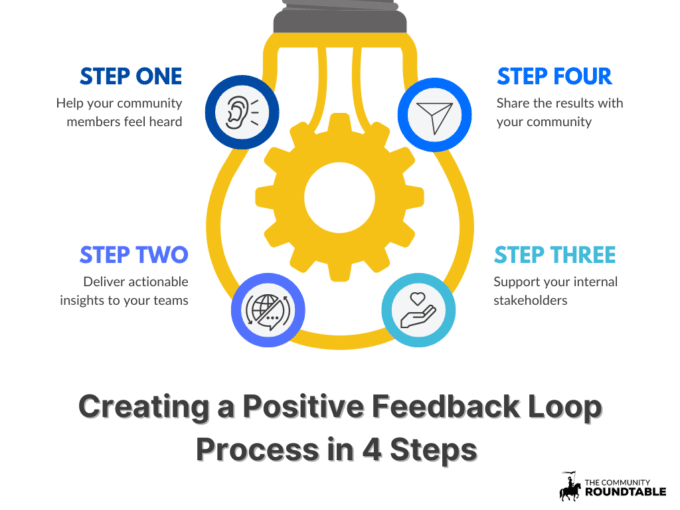As a community manager, there may be days when you find yourself channeling a firefighter more than anything else. Issue after issue (ranging from things as simple as missing an update to as complex as a feature no longer working) rolls in from your members, and you can barely keep up before the next one hits your inbox.
Rather than screaming and fleeing the industry entirely, this is the perfect opportunity to create positive feedback loops to help resolve the issues your community is running into.
What are feedback loops?
Simply put, a feedback loop is when you receive information about an issue in the community from a member, and then share it with the product team for a resolution. Feedback loops can fall into one of two categories: positive and negative.
A positive feedback loop is when you take the commentary from the community member and provide it to the internal stakeholders in a way they can take action to resolve the problem. Their ability to take action is key.
A negative feedback loop, on the other hand, is when you act as a conduit moving the complaint from the member to the product team with no way to really take action to resolve it. In short: not helpful.
So how do you establish a positive feedback loop? Simple. Create a process!
Establishing your positive feedback loop process

The main goal of creating a positive feedback loop is twofold: ensure your members feel heard, and ensure the stakeholders are given the information they can use to improve things. Fortunately, this can be accomplished with an easy four-step process.
Step 1: Help the community feel heard
The first thing you need to do when designing a positive feedback loop is to acknowledge the issue. This step is crucial because it helps members know they’ve been heard. Reply to the member who submitted the information, and thank them for their help. It doesn’t need to be complex or in-depth — in fact, you want to avoid making any promises at this stage as to the resolution — but a simple message will at least help them realize their submission isn’t just sitting in a black hole, never to be heard from again.
Step 2: Deliver actionable insights
Remember the negative feedback loop mentioned earlier? Yeah, that’s what happens when you skip this part of the process. In order to deliver an actionable insight, you need to be able to take the issues you’re hearing from the community members and translate them in a way the product team understands and can act on.
Not sure how to do that? Easy solution: ask. Your stakeholders likely have their own processes in place for their end of things, so ask how they prefer to receive this sort of information. Considering they want to make the products better, too, you should receive little to no pushback when you ask about their workflow.
Step 3: Support your internal stakeholders
This is the step where you have the least to do, as a community manager. After all, the product team is working on the solution. But you still have the opportunity to influence the work that’s being done. How? Simple:
- Be present
- Be encouraging
- Be affirming
By having established a good relationship with the stakeholders, you’ll already know what information is important to them, which allows them to start their end of the work more efficiently.
No relationship yet? Get to know them AND their need to know information. After all, you’re establishing a process with them that will be occurring frequently.
When the product team is done, you’re one step closer to wrapping up!
Step 4: Share the results with the community
Now’s the time to channel your inner Frank Sinatra, and “start spreadin’ the news.” When the work has been completed, there are several ways you should share the information.
- Reach out directly to the member who originally provided the feedback. Even if the solution isn’t exactly what they asked for, by communicating with the originator you’re able to successfully close the loop. Not only that but by closing the loop you may have gained yourself a community champion!
- Share the updates with the larger community. If you need help with talking points or want to share the information with more than just your community members, consider involving communications and/or public relations to assist. They have the contacts and skill sets necessary to assist.
- Reinforce the behavior. Remember, you want your community members to provide feedback. By incorporating the end results into your community’s content calendar, you’ll be able to reinforce the positive results that occur when community members provide feedback while encouraging more of the same behavior.
Remember, when you work in community it’s easy to channel a firefighter’s energy: constantly solving one issue after another. But if you do that, you’re doing a disservice to your community and (just as importantly) to your own sanity. By creating a positive feedback loop process, you’ll solve your community’s issues in a logical way and create positive relationships with both your community members and your product teams.
